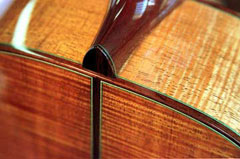
Judy Threet’s website, Threet Guitars, proudly boasts “From my hands to yours,” and truer words were never written. Judy is the quintessential Neanderthal woodworker, one who eschews most tooling for the joys of crafting one-of-a-kind guitars by hand.
“The thing I most value about what I do,” Threet explained “is that I am very personally involved with it. I use few machines, preferring hand tools for most of the work, and that is important to me. Too many people building guitars today seem to hardly ever touch the wood itself. I use a router for cutting the dovetail neck joint and binding ledges, a drill press for holes, a band saw for rough cutout, and a thickness sander for dimensioning, but no table saw, planer, jointer or any of the other ‘standard’ machines many other woodworkers could not live without. All the rest is done by hand.
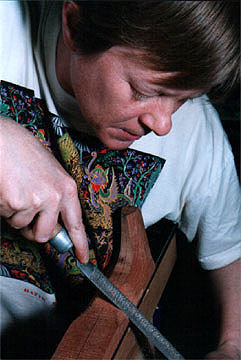
“I love to hand carve necks,” she confessed, “especially with a spoke shave. It’s one of my favorite tools; it makes me giggle every time I use it. I also have a wonderful set of Robert Sorby chisels, and watching how well they work simply fascinates me. It is a very meditative thing to be down close to the wood and watch it being smoothly cut.”
Guitars, however, were not Judy’s first career. “I started in the late 80s doing inlay work for local guitar builder Michael Heiden,” Judy recounted. “Prior to that, I was an academic; I went to school, got a Ph.D. in philosophy at Stanford in 1986, played music in bands, worked in a record store and taught at a university for several years. The first time I ever cut into a piece of wood was while in college during a woodblock-printing course. As an undergraduate, my minor was in printmaking, and I had been drawing since the age of five and have played guitars since I was child.”
As is often the case, she more or less backed into guitar making. “I was in a swing band with Michael, playing a little Martin O-18 model guitar, and he suggested I buy one of his archtop guitars. I said that I would be interested only if he let me watch and take pictures of the process. One day while I was there, he was complaining because he had to stop woodworking to do an inlay. I said ‘If you show me how to do that, I will do it for you.’ He did, and I started doing inlay.
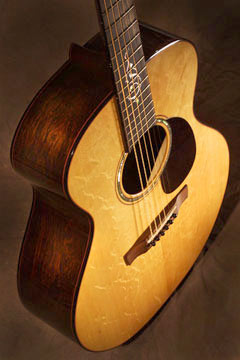
“Meanwhile, I got fed up with teaching and asked Michael to apprentice me as a guitar builder in 1989. It lasted only four months, during which I built one guitar using his tools, jigs, and wood. It was a very short apprenticeship because he had to move out of town to care for his ailing mother.” The first Threet guitar emerged in 1990. “The next five years, I was learning and did a lot of guitar repair, so I did not build all that much. I bought tons of books and read, and read and read. Within a year I had designed my basic guitar and hung out my shingle.”
Currently, Threet produces only eight guitars a year and has a waiting list that at its height was three years’ long. A year-and-a-half ago, she closed the waiting list, refusing to accept new orders until she had a chance to catch up. That’s quite a compliment considering her guitars range from $6,000 for her most basic, unadorned instrument, to over $10,000 for inlaid models.
“I make five different body shapes and sizes. I have only one complete model, called the ‘Deluxe’ and have made about 30 of them, but beyond that, every guitar is unique. These days, no one orders the Deluxe. Everyone wants custom work, and that’s fine with me.
“If they live locally, I invite them to come in. We talk about what kind of music they play and the sound they want to hear. I guide them to a type of wood base on that, and then let them choose from a pile of that wood. They also get to talk about the kinds of decoration they prefer, and I’ll often let them take a swipe with the spoke shave on their guitar’s neck, usually early enough in the process so they are not likely to do any harm. They are always thrilled when they get to do that.”
It is her inlay work, though, that sets her apart from most other guitar makers. Instead of more traditional patterns of leaves, flowers and symmetrical geometric patterns set in pearl and then engraved with black lines, she leans toward realistic imagery. The headstocks of her guitars often sport scenes, or more accurately, snippets of scenes, that look as if you’re viewing only part of a larger picture.
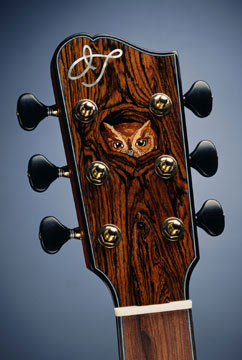
“I was heavily influenced by fellow Canadian guitar maker Grit Laskin,” Threet explained, “who sees inlay as merely a window. You see a segment of the picture, and your mind fills in the rest, just as it would when looking at a scene out a small window. I never paid any attention to inlay until I started doing it myself. By that time, Laskin was one of the shining lights of the industry, and his style seemed rather natural. The big difference between what Grit and I do is that he engraves his inlay and I prefer not to, both because I don’t want my work to look too much like his work, and because I find it more challenging to do my style of collage art without lines. I engrave only when necessary.”
“Inlay is just a glorified jigsaw puzzle,” Judy insists. “You cut out pieces, fit them together and create a bed for them to sit in. I draw the image by hand, then make photocopies, at least one on Mylar®. As I cut a piece, I affix it to the Mylar pattern so that I can slide the Mylar around over other pieces to see if they work together. That took me years to figure out. I pay a lot of attention to the material itself and try to let the material help determine the design. In a sense, it should be a conversation between design and materials.
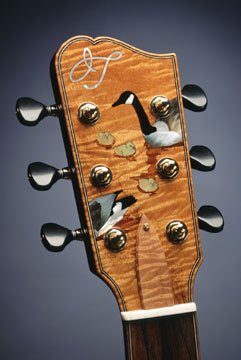
“Pearl has ‘chatoyance,’ a [French] word that describes pattern, grain, and mostly iridescence. You can view that as a tool or an irritant. I use it as a tool. I don’t think about it when designing the inlay, but when I go to cut, I spend at least as much time choosing the piece as I do cutting it. I match the texture of the material to the texture the design needs.
“At times, that can present its own challenges. Recently, I spent two days cutting out the pieces for a hippo. I found two great pieces for the head and hide, but when I put them together, they did not flash correctly next to one another. That’s what takes so much time — finding a piece that is not only spot on for its job, but works with the other ideal pieces in the inlay.
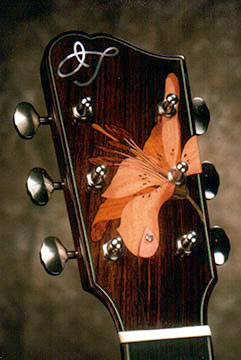
“All that work pays off in ‘pictures’ that dance with realism. On one headstock, two geese swim by in rippling water created by the figure in curly koa. In another, a shy owl peeks out of the natural ‘knothole’ formed by the convoluted grain of bocote veneer.
Art and beauty, though, come at a cost, even to the builder. “If you want to be a guitar maker,” Judy pointed out, “be prepared to take a vow of poverty. Do it because you love it.” Still, there are benefits. “At the end of a day teaching philosophy, you have nothing to show for what you have done. At the end of a day of building guitars or doing inlay, you have something in your hands to show for it.”
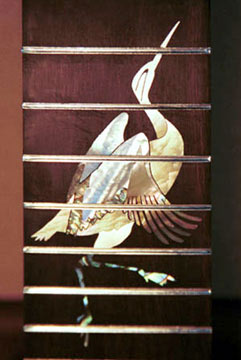
And to the delight of her customers, they have something very special in their hands as well.





